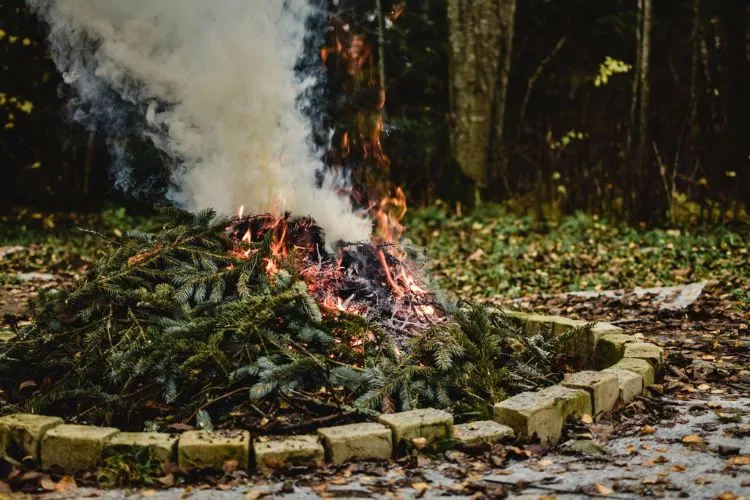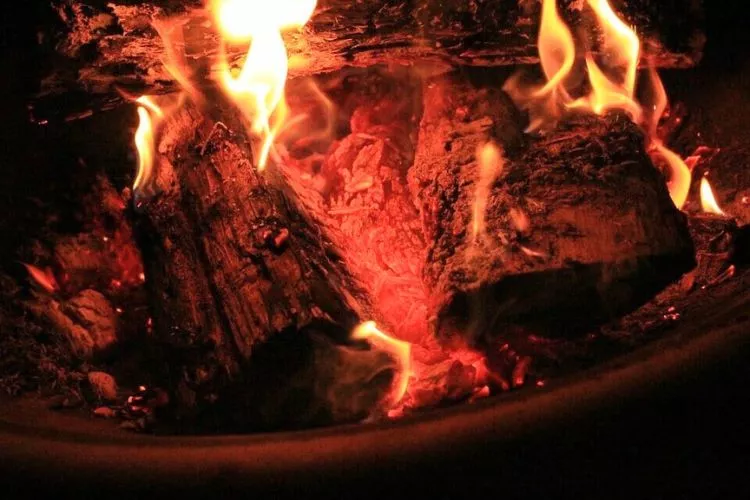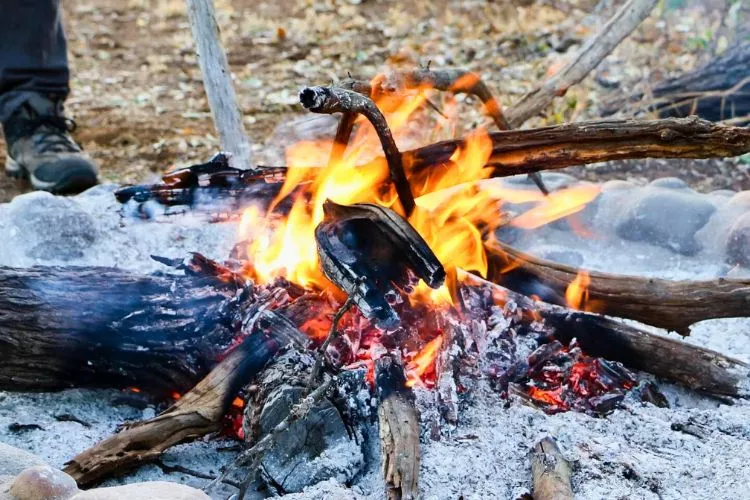You’re planning a cozy bonfire night with friends, but the wind picks up.
You wonder, “How windy is too windy for a fire?” This simple question could mean a fun evening and a catastrophic wildfire.
With the increasing risk of wildfires and their devastating impact on our environment, understanding the role of wind in fire safety is crucial for everyone.

By examining the factors that influence wind speed and direction, I’ll help you understand when it’s safe to strike a match and when it’s best to wait for calmer conditions.
How windy is too windy for a fire?
A wind speed greater than 5 miles per hour (mph) is generally considered too windy for a safe fire, such as a campfire or bonfire.
When determining how windy is too windy for a fire, it is important to consider various factors that can influence the safety of the fire.
While a wind speed greater than 5 miles per hour (mph) is generally considered too windy for a safe fire like a campfire or bonfire, specific conditions such as the type of fire, location, and surrounding environment can play a significant role in fire safety.
For prescribed burns, controlled fires intentionally set for land management purposes, recommended wind speeds typically range from 4 to 15 mph2. However, these wind speeds can vary depending on factors such as:
- Slope: Fires can spread uphill faster, and wind direction can accelerate or slow the fire’s progress. When burning on a slope, it is generally safer to have a lower wind speed and a wind direction aligned with the slope’s contours.
- Vegetation: The type and density of vegetation can influence how easily a fire spreads. Drier and more flammable vegetation may require lower wind speeds to ensure safe burning conditions].
- Weather conditions: Humidity, temperature, and atmospheric stability can all affect fire behavior. Lower humidity and higher temperatures can increase the fire’s intensity, while atmospheric stability can impact the fire’s ability to spread.
- Firebreaks: Adequate firebreaks, or barriers that help prevent the spread of fire, can provide additional safety. In windy conditions, having well-maintained firebreaks can help mitigate the risk of the fire escaping control.
In conclusion, while a general guideline is to avoid starting a fire at wind speeds greater than 5 mph, it is crucial to consider your situation’s specific conditions and factors to determine the safest wind speed for your fire.
How much wind is too windy for a fire pit?
For a fire pit, wind speeds greater than 5 to 10 miles per hour (mph) are generally considered too windy.
Fire pits are often designed to contain small fires and minimize the risk of embers escaping, but strong winds can still blow sparks and embers outside the pit, increasing the risk of unintended fires.

When using a fire pit in windy conditions, taking additional precautions, such as using a spark screen or wind guard, positioning the fire pit away from flammable materials, and monitoring the fire closely is essential.
Furthermore, checking local regulations and guidelines on fire pit usage during windy conditions is crucial for ensuring safety and compliance.
What is too windy for a campfire?
Wind speeds greater than 5 miles per hour (mph) for a campfire are generally considered too windy. In windy conditions, the risk of sparks and embers being blown away from the campfire increases, potentially causing wildfires.
Therefore, when planning a campfire, it is essential to assess the wind speed and direction and choose a sheltered location that reduces the impact of wind on the fire.

Additionally, creating a firebreak by clearing flammable materials around the campfire site, using a fire ring or pan, and keeping the fire small and manageable can help prevent the spread of fire in windy conditions.
Finally, always follow local regulations and guidelines when starting a campfire and be prepared to extinguish the fire if the wind becomes too strong.
How do I protect my fire pit from wind?
To protect your fire pit from wind, follow these tips:
- Keep the ground around your fire pit clear of ashes and debris to prevent sparks from blowing by the wind.
- Use a wind guard or glass panels to shield the fire pit from wind and keep the flame more stable.
- Position the fire pit in a sheltered location, away from prevailing winds and flammable materials.
- Use a spark screen or lid to cover the fire pit and prevent embers from escaping.
- Maintain a small and manageable fire to reduce the risk of wind-driven fire spread.
- Check local regulations and guidelines on fire pit usage during windy conditions to ensure safety and compliance.
Frequently Asked Questions (FAQs)
Is 10 mph too windy for a bonfire?
Yes, 10 mph is generally considered too windy for a bonfire. Wind speeds greater than 5 mph can increase the risk of sparks and embers being blown away from the fire, potentially causing unintended fires. When planning a bonfire, choose a sheltered location and monitor wind conditions to ensure safety.
Can you burn with 8 mph wind?
Burning with an 8 mph wind can be risky, as wind speeds above 5 mph can increase the chances of fire spread. If you must burn in these conditions, take additional precautions such as using a windbreak, creating a firebreak, and closely monitoring the fire to ensure safety.
Is it safe to burn with 10 mph wind?
Burning with a 10 mph wind is generally unsafe, as wind speeds above 5 mph can contribute to the rapid spread of fire. In such conditions, it is advisable to postpone burning activities or take extra precautions to minimize the risk of fire escape and potential wildfires. Always follow local regulations and guidelines.
Essential Safety Precautions for Fires in Windy Conditions
When dealing with fire in windy conditions, safety should always be the top priority. Whether you’re lighting a campfire, managing a bonfire, or using a fire pit, understanding and following key safety measures can significantly reduce the risks associated with wind.
Monitor Weather Conditions Regularly: Wind speeds can change unexpectedly, so it’s essential to check weather forecasts and stay informed about wind conditions before and during your fire activity. Apps and local weather stations can provide real-time updates to help you make informed decisions.
Keep Firefighting Tools Nearby: Always have basic firefighting tools on hand, including a bucket of water, a garden hose, a fire extinguisher, or a shovel with soil or sand. These tools are critical for quickly extinguishing any stray embers or sparks.
Avoid Flammable Liquids: In windy conditions, using flammable accelerants like lighter fluid or gasoline can be extremely dangerous. These liquids can ignite unpredictably and worsen fire control. Stick to natural fire starters like dry wood, paper, or kindling.
Establish a Safe Perimeter: Create a firebreak by clearing flammable materials such as dry leaves, twigs, and grass within at least 10 feet of the fire. This buffer zone reduces the chances of stray embers igniting nearby vegetation.
Use Wind Barriers: If you must have a fire during slightly windy conditions, consider setting up windbreaks using non-flammable barriers like fire pit screens, metal sheets, or natural structures such as large rocks. These barriers can help block gusts of wind and keep embers contained.
Be Ready to Extinguish the Fire Immediately: If wind conditions worsen while your fire is burning, don’t hesitate to extinguish the fire completely. Douse it with water, stir the ashes, and ensure no embers are smoldering before leaving the site.
By combining preparation, situational awareness, and the right tools, you can minimize fire-related risks and enjoy a safer outdoor experience, even in mildly windy conditions.
Conclusion:
Understanding the relationship between wind and fire safety is crucial for preventing wildfires and ensuring responsible fire management.
While a general guideline suggests that wind speeds above 5 mph are too windy for a safe fire, it is essential to consider the specific conditions, location, and type of fire before starting any burning activity.
By taking appropriate precautions, such as selecting sheltered locations, using firebreaks, and monitoring wind conditions, we can minimize the risk of fire spread and contribute to a safer environment for everyone.
Remember, it is always better to err on the side of caution and respect wind power when it comes to fire safety.


